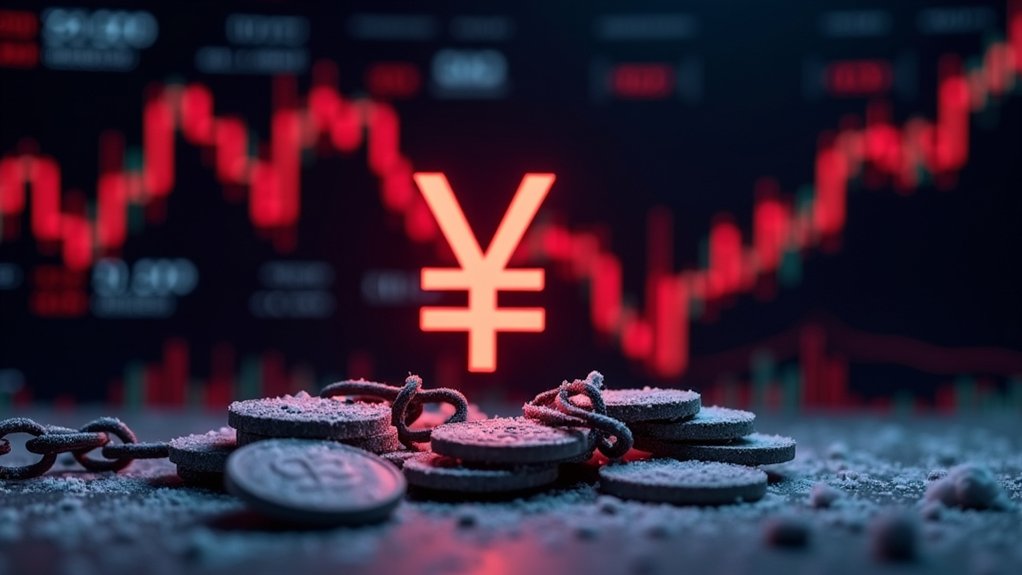Network congestion in cryptocurrency networks happens when too many people try to make transactions at once, similar to a traffic jam on a busy highway. This overload causes slower processing times and higher transaction fees as users compete to get their transactions processed first. It’s especially common during major market events or when popular crypto applications strain the system. The crypto industry is developing various solutions like the Lightning Network and sharding to tackle these congestion challenges.
Quick Overview
- Network congestion occurs when blockchain networks become overloaded with too many simultaneous transaction requests, similar to traffic jams.
- During congestion, users experience higher transaction fees and longer confirmation times as transactions compete for processing priority.
- Popular activities like DeFi trading, NFT minting, and increased cryptocurrency adoption contribute to network congestion.
- Network congestion impacts cryptocurrency usability by making transactions more expensive and slower during peak usage periods.
- Solutions like SegWit, Lightning Network, and sharding are being developed to help manage and reduce network congestion.

While cryptocurrencies have revolutionized digital payments, network congestion remains a persistent challenge that affects millions of users worldwide. This congestion happens when there are too many transactions for the network to handle quickly. It’s similar to a traffic jam on a highway, where too many cars try to use the same road at once. Several factors can trigger this congestion, including sudden spikes in trading activity, major market events, or technical changes to the network. During the peak of network congestion in late 2017, average Bitcoin fees exceeded $50. The CryptoKitties incident in 2017 demonstrated how a single popular application could severely impact Ethereum’s network performance. DeFi platforms have become a major contributor to network congestion due to their increasing popularity and transaction volumes.
When networks get congested, users face higher transaction fees as they compete to get their transactions processed first. It’s like bidding for limited space in each block of transactions. Those who pay higher fees usually get their transactions confirmed faster, while others might wait longer or even see their transactions remain stuck for hours or days. This slowdown can make it frustrating for people trying to send or receive cryptocurrency.
The effects of network congestion ripple throughout the entire cryptocurrency ecosystem. When transactions take longer to process, it can cause price swings in the market as trades don’t execute immediately. This delay makes it harder for people to use cryptocurrencies for everyday purchases. High fees during congestion also create an unfair advantage for wealthy users who can afford to pay more to get their transactions through quickly. Smart contracts automatically execute transactions, which can further strain network capacity during peak times.
To tackle these problems, the cryptocurrency community has developed several solutions. One approach is SegWit, which changes how transaction data is stored to fit more transactions in each block. The Lightning Network offers another solution by processing some transactions outside the main blockchain, making them faster and cheaper.
Some projects are exploring sharding, which splits the network into smaller pieces that can process transactions in parallel. Network developers are also working on sidechains and transaction batching to help ease congestion. These tools work like express lanes on a highway, providing alternative routes for transactions to flow through.
Meanwhile, new blockchains have emerged that can handle more transactions per second, though they often trade off some security or decentralization to achieve this speed. As cryptocurrency adoption grows, solving network congestion becomes increasingly important.
While current solutions have helped, they’re still being refined and improved. The challenge of balancing speed, security, and accessibility continues to drive innovation in the cryptocurrency space, leading to new technologies and approaches for managing transaction flow.
Frequently Asked Questions
How Can I Predict When Network Congestion Will Occur?
Network congestion can be predicted by watching key indicators.
Blockchain explorers show real-time data about mempool size and transaction fees. Historical patterns reveal how congestion happens during big events like token launches or market spikes.
Machine learning models analyze past data to spot trends. Community alerts from crypto exchanges and social media also signal when the network’s getting busy.
Together, these tools help track when congestion might occur.
Do All Cryptocurrencies Experience the Same Level of Network Congestion?
No, cryptocurrencies don’t experience the same congestion levels.
Some networks, like Bitcoin and Ethereum, often face more congestion due to their popularity and design.
Newer blockchains, like Solana, can handle more transactions per second.
Each cryptocurrency’s network has different features that affect congestion: block size, processing speed, and user activity all play a role.
Plus, some networks use special solutions like Layer 2 to reduce traffic jams.
Can Network Congestion Affect the Security of My Cryptocurrency Transactions?
Network congestion can indeed affect cryptocurrency transaction security.
When the network is clogged, transactions take longer to confirm, which opens up opportunities for double-spending attacks. During congested periods, unconfirmed transactions are more vulnerable to being replaced or manipulated.
There’s also a higher risk of fraud, especially for time-sensitive services.
While Layer-2 solutions and multi-signature wallets help address these issues, congestion remains a notable security concern.
What Role Do Mining Pools Play in Network Congestion?
Mining pools play a significant role in managing network traffic. They’re groups of miners who work together to process transactions and can influence how quickly transactions get processed.
Large pools have more control over which transactions go through first, usually picking ones with higher fees. When pools prioritize certain transactions, it can create bottlenecks for others.
Pool size and location also affect how fast blocks spread across the network.
Are There Any Tools to Monitor Real-Time Network Congestion?
Several popular tools help users track network congestion in real time.
ETH Gas Station shows Ethereum’s gas prices, while BTC Network monitors Bitcoin’s mempool and fees.
Blockchain.info provides charts showing Bitcoin’s transaction volumes.
Etherscan tracks Ethereum’s network status, and CoinGecko offers a multi-chain gas tracker.
These tools update frequently and show important data like transaction backlogs and fee estimates across different networks.





